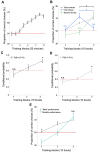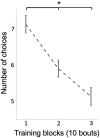Bumblebees Learn a Relational Rule but Switch to a Win-Stay/Lose-Switch Heuristic After Extensive Training
- PMID: 32903410
- PMCID: PMC7434978
- DOI: 10.3389/fnbeh.2020.00137
Bumblebees Learn a Relational Rule but Switch to a Win-Stay/Lose-Switch Heuristic After Extensive Training
Abstract
Mapping animal performance in a behavioral task to underlying cognitive mechanisms and strategies is rarely straightforward, since a task may be solvable in more than one manner. Here, we show that bumblebees perform well on a concept-based visual discrimination task but spontaneously switch from a concept-based solution to a simpler heuristic with extended training, all while continually increasing performance. Bumblebees were trained in an arena to find rewards on displays with shapes of different sizes where they could not use low-level visual cues. One group of bees was rewarded at displays with larger shapes and another group at displays with smaller shapes. Analysis of total choices shows bees increased their performance over 30 bouts to above chance. However, analyses of first and sequential choices suggest that after approximately 20 bouts, bumblebees changed to a win-stay/lose-switch strategy. Comparing bees' behavior to a probabilistic model based on a win-stay/lose-switch strategy further supports the idea that bees changed strategies with extensive training. Analyses of unrewarded tests indicate that bumblebees learned and retained the concept of relative size even after they had already switched to a win-stay, lost-shift strategy. We propose that the reason for this strategy switching may be due to cognitive flexibility and efficiency.
Keywords: abstract concepts; adaptive decision-making; animal cognition; behavioral analyses; cognitive flexibility; cognitive offloading; the law of least effort.
Copyright © 2020 MaBouDi, Solvi and Chittka.
Figures




References
-
- Carere C., Locurto C. (2011). Interaction between animal personality and animal cognition. Curr. Zool. 57, 491–498. 10.1093/czoolo/57.4.491 - DOI
-
- Chittka L., Gumbert A., Kunze J. (1997). Foraging dynamics of bumble bees: correlates of movements within and between plant species. Behav. Ecol. 8, 239–249. 10.1093/beheco/8.3.239 - DOI
Grants and funding
LinkOut - more resources
Full Text Sources
Other Literature Sources
Miscellaneous

